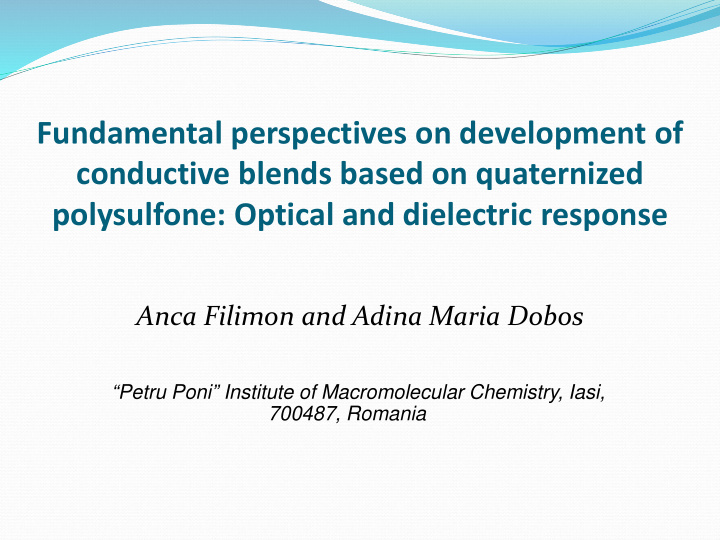



Fundamental perspectives on development of conductive blends based on quaternized polysulfone: Optical and dielectric response Anca Filimon and Adina Maria Dobos “Petru Poni” Institute of Macromolecular Chemistry, Iasi, 700487, Romania
OBJECTIVES Analysis and understanding of the polarization and conductivity mechanisms exhibited in new blends based on quaternized polysulfones (i.e., quaternized polysulfone/cellulose acetate phthalate – PSFQ/CAP). Improvement of the ionic conductivity and also optimization of optical and dielectric properties of films based on quaternized polysulfone blend for better electrical performances required by the ionic exchange membranes.
Optical and Dielectric Measurements Chemical and conformational structures Transmittance: (with minimized energies, considering four - SPECORD 200 Analitik-Jena repeating units) of quaternized polysulfone (PSFQ) spectrophotometer - 200-1100 nm wavelengths. and cellulose acetate phthalate (CAP) Dielectric spectroscopy: - Novocontrol Concept 40 broadband dielectric spectrometer; - temperature was controlled with a 0.1 °C device by the Novocontrol Quatro Cryosystem, in dry nitrogen atmosphere; - samples were sandwiched between two gold-coated brass electrodes and tested by sweeping the frequency between 10-10 6 Hz, over a temperature domain between -120 and +120 °C.
Optical parameters: E gap - optical gap energy E urbach - Urbach edge energy E tail - Urbach tail Urbach energies obtained for studied polymeric films increase as the transparency of samples increase. For PSFQ film, which is less transparent, E urbach value is smaller comparatively with the values of Urhach energies obtained for polymeric films with higher transparency (CAP and 70/30 wt./wt. PSFQ/CAP). E tail energy of CAP sample presents a higher value than for PSFQ and for their blends. Transmission spectra, initiated in the Variation of these parameters is related to ultraviolet domain, present a high the localized state induced by the atomic transparency value of about 90 % structures of the polymers.
Competition between the contributions of the main chain and the pendant groups is observed in: ε ' >> ε ' dielectric constant increases with PSFQ CAP increasing of temperature due to the electronic conjugations from the side chains of the enhancement of total PSFQ contribute to the enhancement of ε' values polarization, arising from dipoles orientation and trapped charge the decrease in ε' values for CAP may be attributed carriers to: dielectric constant decreases with - the ability of macromolecules dipoles to orient increasing of frequency due to themselves in the direction of the applied field in dielectric dispersion as a result of the low frequency range; molecules lagging behind the alternation of the electric field, at - dipoles will hardly be able to orient themselves in higher frequencies. the direction of the applied field, in the high frequency range
Relaxation processes illustrated in tridimensional variation of dielectric loss, ε”, with frequency and temperature two types of relaxation, γ and β, appear. Polysulfone side chain Relaxation processes occur produces: in polymers blend as result The main chain involves a - a decrease in the interchain of the relaxations localized and attraction manifested in the temperatures at which the non-cooperative starting chloromethylated two processes occur in the spectrum of motions. polysulfone; case of pure components. - imparts skeleton rigidity. In the used frequency range, the main contribution to dielectric relaxation appears only for the side groups motion, no contribution from the backbone of the main chain being noticed.
Variation of electrical conductivity, σ , with temperature and frequency is dependent on the structural parameters of the samples The electrical conductivity, The electrical besides the electronic The linear dependence of conductivity of the conduction is accompanied conductivity on frequency studied samples can be by an ionic conduction around room temperature explained in terms of generated by the (30 ° C) is due to electronic band conduction N,N-dimethylbutylamonium conduction via a hopping mechanisms, through group from the quaternized process. band gap polysulfone. representation. Deviation from linearity at high frequencies may be due to the dispersion of the charge carriers produced by dipolar relaxation.
CONCLUSIONS New blends of quaternized polysulfone/cellulose acetate phthalate provide a perspective for future approaches in industrial applications, due to the dielectric properties, conductivity, and implicitly electron interactions which represent fundamental features to enhance their electrical performance. Findings of this study demonstrate that the blends based on quaternized polysulfones may offer important advantages for membrane applications, e.g., ionic exchange membranes.
Recommend
More recommend